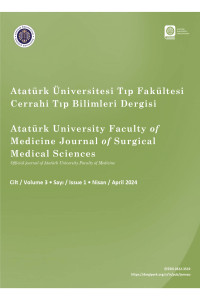Abstract
Amaç
Radyasyon onkoloji servisinde yatan kanser hastalarının beslenme durumları net değildir. Kanser hastaları üzerinde yapılan bu kesitsel çalışma, bu hasta grubundaki malnütrisyon riskinin yaygınlığını araştırmayı amaçladı.
Yöntem
Aralık 2018 ile Ocak 2022 tarihleri arasında radyasyon onkolojisi servisinde radyoterapi gören 373 hastayı retrospektif olarak araştırdık. Hastaların demografik bilgileri, NRS-2002 skoru, radyoterapiye ilişkin doz ve fraksiyon verileri toplandı.
Sonuç
Hastaların çoğunluğu (%66) erkekti. Küçük hücreli dışı akciğer kanseri (KHDAK) en sık görülen birincil tanıydı. Radyoterapinin birincil amacı 210 hastada (%56,3) palyatif radyoterapiydi. Hastaların çoğunluğunun (%46,4) normal BMI aralığında olduğu görüldü. Yatan hasta başvurusunda NRS-2002 skorlamasında hastaların %1,9'unun puanı ≥3 idi.
Tartışma
Araştırmanın sonucu radyasyon onkolojisi yataklı servisinde yetersiz beslenme oranının yüksek olmadığını gösteriyor. Ancak malnütrisyona yönelik sistematik bir taramanın yapılması ve hastaların multidisipliner beslenme ekibiyle desteklenmesi yataklı tedavi hizmetlerinde kanserli hasta bakımının anahtarıdır.
Keywords
References
- Aprile G, Basile D, Giaretta R, et al. The Clinical Value of Nutritional Care before and during Active Cancer Treatment. Nutrients. 2021;13(4):1196.
- Arends J, Bachmann P, Baracos V, et al. ESPEN guidelines on nutrition in cancer patients. Clinical Nutrition. 2017;36(1):11-48.
- Isenring E, Elia M. Which screening method is appropriate for older cancer patients at risk for malnutrition? Nutrition. 2015;31(4):594-597.
- Martin L, Senesse P, Gioulbasanis I, et al. Diagnostic Criteria for the Classification of Cancer-Associated Weight Loss. Journal of Clinical Oncology. 2015;33(1):90-99.
- Lee SC, Wang TJ, Chu PY. Predictors of weight loss during and after radiotherapy in patients with head and neck cancer: A longitudinal study. European Journal of Oncology Nursing. 2019;39:98-104.
- Leandro-Merhi VA, de Aquino JLB, Reis LO. Predictors of Nutritional Risk According to NRS-2002 and Calf Circumference in Hospitalized Older Adults with Neoplasms. Nutrition and Cancer. 2017;69(8):1219-1226.
- Sørbye LW. Cancer in home care: Unintended weight loss and ethical challenges. A cross-sectional study of older people at 11 sites in Europe. Archives of Gerontology and Geriatrics. 2011;53(1):64-69.
- van den Berg MGA, Rütten H, Rasmussen‐Conrad EL, et al. Nutritional status, food intake, and dysphagia in long‐term survivors with head and neck cancer treated with chemoradiotherapy: A cross‐sectional study. Head & Neck. 2013;36(1):60-65.
- Marar M, Gabriel P, Hwang WT, et al. Acute Hospital Encounters in Cancer Patients Treated With Definitive Radiation Therapy. International Journal of Radiation Oncology*Biology*Physics. 2018;101(4):935-944.
- Kondrup J. Nutritional risk screening (NRS 2002): a new method based on an analysis of controlled clinical trials. Clinical Nutrition. 2003;22(3):321-336.
- Planas M, Álvarez-Hernández J, León-Sanz M, Celaya-Pérez S, Araujo K, García de Lorenzo A. Prevalence of hospital malnutrition in cancer patients: a sub-analysis of the PREDyCES® study. Supportive Care in Cancer. 2015;24(1):429-435.
Abstract
Aim
The nutritional status of cancer patients in radiation oncology inpatient service is not clear. This cross sectional study on patients with cancer aimed to search the prevalence of the risk of malnutrition in this patient group.
Materials & Methods
We retrospectively searched 373 patients who got radiation therapy in radiation oncology inpatient unit between December 2018 and January 2022. Patients’ demographic information, NRS-2002 score, dose and fractionation data about radiation treatment collected.
Results
The majority of patients (66%) was male. Non-small cell lung cancer (NSCLC) was the most common primary diagnosis. The primary intent of radiotherapy was palliative radiotherapy for 210 patients (56.3%). Majority of patients (46.4%) had in normal BMI range. 1.9% of patients’ score was ≥3 in NRS-2002 scoring at inpatient admission.
Conclusion
The result of the survey does not show high malnutrition rate in radiation oncology inpatient service. However, the importance of the need for a systematic screening for malnutrition and supporting patients with multidisciplinary nutrition team is the key of cancer care in inpatient services.
Keywords
References
- Aprile G, Basile D, Giaretta R, et al. The Clinical Value of Nutritional Care before and during Active Cancer Treatment. Nutrients. 2021;13(4):1196.
- Arends J, Bachmann P, Baracos V, et al. ESPEN guidelines on nutrition in cancer patients. Clinical Nutrition. 2017;36(1):11-48.
- Isenring E, Elia M. Which screening method is appropriate for older cancer patients at risk for malnutrition? Nutrition. 2015;31(4):594-597.
- Martin L, Senesse P, Gioulbasanis I, et al. Diagnostic Criteria for the Classification of Cancer-Associated Weight Loss. Journal of Clinical Oncology. 2015;33(1):90-99.
- Lee SC, Wang TJ, Chu PY. Predictors of weight loss during and after radiotherapy in patients with head and neck cancer: A longitudinal study. European Journal of Oncology Nursing. 2019;39:98-104.
- Leandro-Merhi VA, de Aquino JLB, Reis LO. Predictors of Nutritional Risk According to NRS-2002 and Calf Circumference in Hospitalized Older Adults with Neoplasms. Nutrition and Cancer. 2017;69(8):1219-1226.
- Sørbye LW. Cancer in home care: Unintended weight loss and ethical challenges. A cross-sectional study of older people at 11 sites in Europe. Archives of Gerontology and Geriatrics. 2011;53(1):64-69.
- van den Berg MGA, Rütten H, Rasmussen‐Conrad EL, et al. Nutritional status, food intake, and dysphagia in long‐term survivors with head and neck cancer treated with chemoradiotherapy: A cross‐sectional study. Head & Neck. 2013;36(1):60-65.
- Marar M, Gabriel P, Hwang WT, et al. Acute Hospital Encounters in Cancer Patients Treated With Definitive Radiation Therapy. International Journal of Radiation Oncology*Biology*Physics. 2018;101(4):935-944.
- Kondrup J. Nutritional risk screening (NRS 2002): a new method based on an analysis of controlled clinical trials. Clinical Nutrition. 2003;22(3):321-336.
- Planas M, Álvarez-Hernández J, León-Sanz M, Celaya-Pérez S, Araujo K, García de Lorenzo A. Prevalence of hospital malnutrition in cancer patients: a sub-analysis of the PREDyCES® study. Supportive Care in Cancer. 2015;24(1):429-435.
Details
| Primary Language | Turkish |
|---|---|
| Subjects | Surgery (Other) |
| Journal Section | Research Articles |
| Authors | |
| Publication Date | April 30, 2024 |
| Submission Date | December 3, 2023 |
| Acceptance Date | January 30, 2024 |
| Published in Issue | Year 2024 Volume: 3 Issue: 1 |


